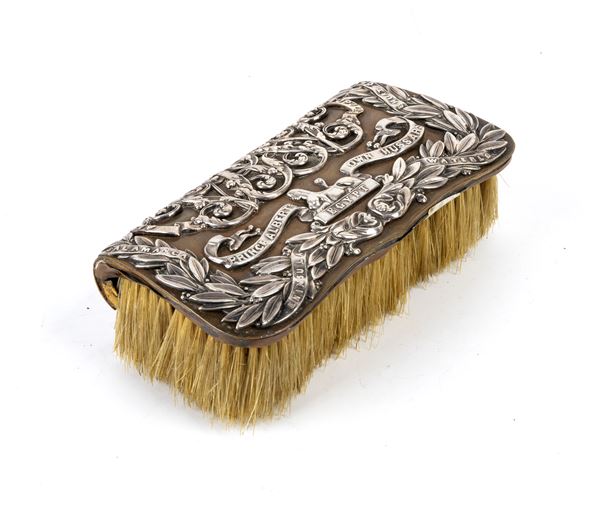245
English horse brush of the 11th Hussars Regiment (Prince Albert's Own), Mid-19th Century
Height x width x depth: 5 x 17 x 9 cm. Weight: 374 g.
with original bristles and silver decorations with garlands framing a scroll with central sphinx bearing the inscriptions: ‘PRINCE ALBERTS EGYPT OWN HUSSARS.’ and on the sides ‘WATERLOO - B HURTPORE - BALAKLAVA - INKERMAN SEVASTOPOL - PENINSULA - SALAMANCA - ALMA’.
The 11th Hussars (Prince Albert's Own) was a cavalry regiment of the British Army, established in 1715. It served for three centuries, taking part in both the First and Second World Wars, before being merged with the 10th Royal Hussars (Prince of Wales' Own) to form the Royal Hussars in 1969.
The regiment was created in Colchester in July 1715 in response to the Jacobite Rising of that year. After a brief deployment to Egypt during the successful campaign of 1801, the regiment returned to significant operations in 1811 when it was sent to Portugal to take part in the Peninsular War. In August of that year, a group of ten soldiers was captured at San Martín de Trevejo in Spain, an incident that may have given rise to the regiment's nickname, The Cherry Pickers, linked to an event near a cherry orchard. Among its most notable actions, the regiment fought at Badajoz in April 1812 and Salamanca in July of the same year before returning to Britain. In 1815, it was assigned to Vandeleur's 4th Cavalry Brigade and participated in the battles of Quatre Bras and Waterloo.
In 1840, the 11th Hussars was designated as an escort for Prince Albert upon his arrival in England for his marriage to Queen Victoria. The queen later appointed him honorary colonel of the regiment, which was subsequently renamed the 11th Hussars (Prince Albert's Own). Albert personally contributed to the design of the regiment's new uniforms, which featured the iconic crimson trousers, known as the "cherry" color.
The 11th Hussars (Prince Albert's Own) was a cavalry regiment of the British Army, established in 1715. It served for three centuries, taking part in both the First and Second World Wars, before being merged with the 10th Royal Hussars (Prince of Wales' Own) to form the Royal Hussars in 1969.
The regiment was created in Colchester in July 1715 in response to the Jacobite Rising of that year. After a brief deployment to Egypt during the successful campaign of 1801, the regiment returned to significant operations in 1811 when it was sent to Portugal to take part in the Peninsular War. In August of that year, a group of ten soldiers was captured at San Martín de Trevejo in Spain, an incident that may have given rise to the regiment's nickname, The Cherry Pickers, linked to an event near a cherry orchard. Among its most notable actions, the regiment fought at Badajoz in April 1812 and Salamanca in July of the same year before returning to Britain. In 1815, it was assigned to Vandeleur's 4th Cavalry Brigade and participated in the battles of Quatre Bras and Waterloo.
In 1840, the 11th Hussars was designated as an escort for Prince Albert upon his arrival in England for his marriage to Queen Victoria. The queen later appointed him honorary colonel of the regiment, which was subsequently renamed the 11th Hussars (Prince Albert's Own). Albert personally contributed to the design of the regiment's new uniforms, which featured the iconic crimson trousers, known as the "cherry" color.
Live auction 327
Curiosities from European and Oriental Art
Curiosities from European and Oriental Art
Silvers, Ivories, Corals, Icons and Wunderkammer
Palazzo Caetani Lovatelli, tue 25 February 2025
FIRST SESSION
25/02/2025 Hours 12:00 pm
Lots 1/167
SECOND SESSION
25/02/2025 Hours 04:00 pm
Lots 168/346




